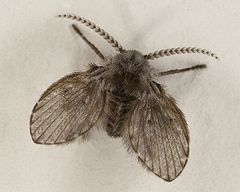- Psychodidae
-
Moth flies 
Clogmia albipunctata Scientific classification Kingdom: Animalia Phylum: Arthropoda Class: Insecta Order: Diptera Suborder: Nematocera Infraorder: Psychodomorpha Superfamily: Psychodoidea Family: Psychodidae Subfamilies Bruchomyiinae
Horaiellinae
Phlebotominae
Psychodinae
Sycoracinae
TrichomyiinaeThe nematoceran family Psychodidae (moth flies or drain flies) are small true flies (Diptera) with short, hairy bodies and wings giving them a "furry" moth-like appearance. The adults have long antennae and the wings are leaf-shaped, either slender or broad, with the most elementary wing venation of any Diptera, having little more than a series of parallel veins without crossveins. Adult Psychodidae are typically nocturnal and associated with damp habitats. The larvae of the subfamilies Psychodinae, Sycoracinae and Horaiellinae live in aquatic to semi-terrestrial habitats, including bathroom sinks; some species are commonly nuisance pests in bathrooms. These pests are commonly removed through use of boiling water, bleach, or drain cleaner. [1]
The subfamily Phlebotominae includes many blood feeding species; they are inhabitants of more arid regions and are often called "sand flies" outside the USA (where "sand flies" are distantly related Nematocera of the Ceratopogonidae). This subfamily is sometimes treated as a separate family Phlebotomidae; the type genus is Phlebotomus. Phlebotominae are a very important group medically, transmitting various tropical diseases, but most importantly kala azar leishmaniasis.
In the New World, the genus incriminated for the transmission of leishmaniasis is Lutzomyia. Lu. chagasi is responsible for the visceral form, while others like Lu. gomezi and Lu. longipalpis may be responsible for transmitting the cutaneous and muco-cutaneous forms of this tropical disease.
Sycoracinae, another subfamily, is also of hematophagous habits, being parasitic on frogs. The European species Sycorax silacea Haliday in Curtis, 1839 has been shown to transmit microfilarian worms. [2]
References
- Quate, L.W. 1955. A revision of the Psychodidae (Diptera) in America north of Mexico. University of California Publications in Entomology.
- Quate, L.W. & B.V. Brown. 2004. Revision of Neotropical Setomimini (Diptera: Psychodidae: Psychodinae). Contributions in Science, 500: 1-117.
- Vaillant, F. 1971. Psychodidae - Psychodinae. In: E. Lindner, ed. Die Fliegen der Palaearktischen Region, 9d, Lieferung 287: 1-48.
- Young, D.G. & P.V. Perkins. 1984. Phlebotomine sand flies of North America (Diptera: Psychodidae). Mosquito News, 44: 263-304.
- ^ Denny Schrock (31 January 2004). Ortho home gardener's problem solver. Meredith Books. ISBN 9780897215046. http://books.google.com/books?id=RVHanXD-5-IC. Retrieved 1 August 2011.
- ^ Desportes, C. 1941. Forcipomyia velox Winn et Sycorax silacea Curtis, vecteurs dIcosiella neglecta (Diesing, 1850) filaire commune de la grenouille verte. Annals de Parasitologie Humaine et Compareè, 19: 53-68..
External links

This article related to members of the insect order Diptera (true flies) is a stub. You can help Wikipedia by expanding it.
